|
The Swastika
Similar Prehistoric Art...
Page 140
tudinally through the center.
The end shows a cross of the Greek form with this
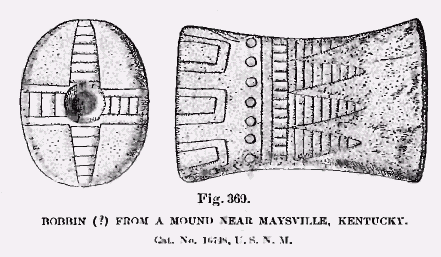 hole in the center of the
cross. Fig. 370 shows a similar object from Lexington, Ky., sent by the
Kentucky University. It is of fine-grained sandstone, is drilled longitudinally
through the center and decorated as shown. The end view shows a series
of concentric circles with rows of dots in the intervals. Fig. 371 shows
a
hole in the center of the
cross. Fig. 370 shows a similar object from Lexington, Ky., sent by the
Kentucky University. It is of fine-grained sandstone, is drilled longitudinally
through the center and decorated as shown. The end view shows a series
of concentric circles with rows of dots in the intervals. Fig. 371 shows
a
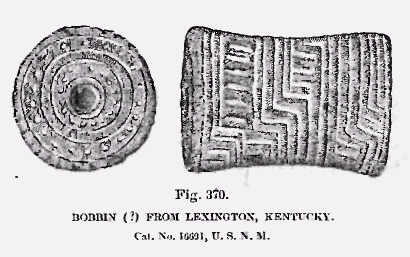 similar object of fine-grained
sandstone from Lewis County, Ky. It is also drilled longitudinally, and
is decorated with rows of zigzag lines as shown. The end view represents
four consecutive pentagons laid one on top of the other, which increase
in size as they go outward, the hole through the bobbin being in the center
of these pentagons, while the outside line is decorated with spikes or
rays extending to the periphery of the bobbin, all of which is said to
represent the sun. The specimen
similar object of fine-grained
sandstone from Lewis County, Ky. It is also drilled longitudinally, and
is decorated with rows of zigzag lines as shown. The end view represents
four consecutive pentagons laid one on top of the other, which increase
in size as they go outward, the hole through the bobbin being in the center
of these pentagons, while the outside line is decorated with spikes or
rays extending to the periphery of the bobbin, all of which is said to
represent the sun. The specimen
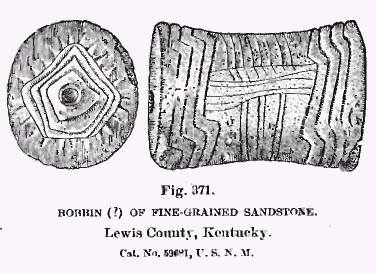 shown in fig. 372, of fine-grained
sandstone, is form Maysville, Ky. the two ends are here represented because
of the peculiarity of the decoration. In the center is hole, next to it
is a rude form of Greek cross which on one end is repeated as it goes
farther from the center; on the other, the decoration consists of three
concentric circles, one interval of which is divided by radiating lines
at regular intervals, each forming a rectangle. Between the outer lines
and the periphery are four radiating rays which, if completed all around,
might form a sun symbol. Bobbins of clay have been lately discovered in
Florida by Mr. Clarence B. Moore and noted by Professor Holmes.
shown in fig. 372, of fine-grained
sandstone, is form Maysville, Ky. the two ends are here represented because
of the peculiarity of the decoration. In the center is hole, next to it
is a rude form of Greek cross which on one end is repeated as it goes
farther from the center; on the other, the decoration consists of three
concentric circles, one interval of which is divided by radiating lines
at regular intervals, each forming a rectangle. Between the outer lines
and the periphery are four radiating rays which, if completed all around,
might form a sun symbol. Bobbins of clay have been lately discovered in
Florida by Mr. Clarence B. Moore and noted by Professor Holmes.
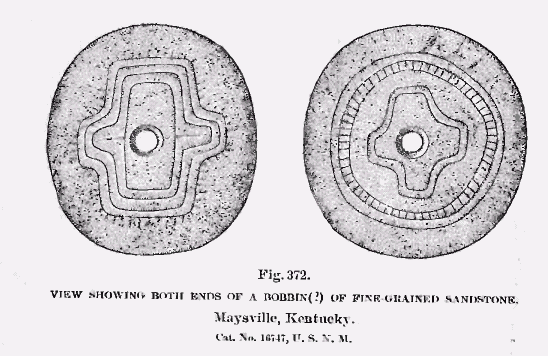 Thus
we find some of the same objects which in Europe were made and used by
prehistoric man and which bore the Swastika mark have migrated to America,
also in prehistoric times, where they were put to the same use and served
the same purpose. This is certainly no inconsiderable testimony in favor
of the migration of the sign.
Thus
we find some of the same objects which in Europe were made and used by
prehistoric man and which bore the Swastika mark have migrated to America,
also in prehistoric times, where they were put to the same use and served
the same purpose. This is certainly no inconsiderable testimony in favor
of the migration of the sign.
VIII. --- Similar Prehistoric
Art, Industries, and Implements In Europe and America as Evidence of
the Migration of Culture.
The prehistoric objects described
in the foregoing chapter are not the only ones 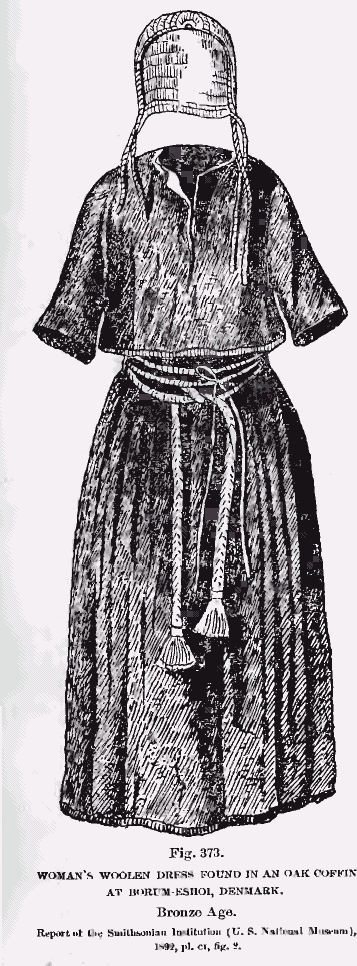 common
to both Europe and America. Related to the spindle-whorls and bobbins
is the art of weaving, and it is perfectly susceptible of demonstration
that this art of weaving, and it is perfectly susceptible of demonstration
that this art was practiced in the two hemisphere in prehistoric times.
Woven frabrics have been found in the Swiss lake dwellings, in Scandinavia,
and in nearly all parts of Europe. They belonged to the Neolthic and Bronze
ages. common
to both Europe and America. Related to the spindle-whorls and bobbins
is the art of weaving, and it is perfectly susceptible of demonstration
that this art of weaving, and it is perfectly susceptible of demonstration
that this art was practiced in the two hemisphere in prehistoric times.
Woven frabrics have been found in the Swiss lake dwellings, in Scandinavia,
and in nearly all parts of Europe. They belonged to the Neolthic and Bronze
ages.
Figs. 373 and 374
illustrate textile fabrics in the Bronze Age. Both specimens are from
Denmark, and the National Museum possesses another specimen (Cat. No.
136615) in all respects similar. While prehistoric looms may not have
been found in Europe to be compared with the looms of modern savages in
America, yet these specimens of cloth, with the hundreds of others found
in the Swiss lake dwellings, afford the most indubitable proof of the
use of the looms in both countries during prehistoric times.
Complementary to this, textile fabrics
have been found in America, from the Pueblo country of Utah and Colorado,
south through Mexico, Central and South America, and of necessity the
looms with which they were made were there also. It is not meant to be
said that the looms of the two hemispheres have been found, or that they
or the textile fabrics are identical. The prehistoric looms have not been
found in Europe to be compared with the looms of modern savages in America,
yet these specimens of cloth, with the hundreds of others found in the
Swiss lake dwellings, afford the most indubitable proof of the use of
the looms in both countries during prehistoric times.
Complementary to this, textile fabrics
have been found in America, from the Pueblo country of Utah and Colorado,
south through Mexico, Central and South America, and of necessity the
looms with which they were made were there also. It is not meant to be
said that the looms of the two hemispheres have been found, or that they
or the textile fabrics are identical. The prehistoric looms have not been
found in Europe, and those in Merica may have been affected by contact
with the white man. Nor is it meant to be said that the textile fabrics
of
ENDNOTES:
H. Mis. 90, pt
2------62
<< Previous Page
Next
Page >>
© 2004-2007 Northvegr.
Most of the material on this site is in the public domain. However, many people have worked very hard to bring these texts to you so if you do use the work, we would appreciate it if you could give credit to both the Northvegr site and to the individuals who worked to bring you these texts. A small number of texts are copyrighted and cannot be used without the author's permission. Any text that is copyrighted will have a clear notation of such on the main index page for that text. Inquiries
can be sent to info@northvegr.org.
Northvegr™ and the Northvegr symbol are trademarks and service marks
of the Northvegr Foundation.
|
> Northvegr™ Foundation
>> About Northvegr Foundation
>> What's New
>> Contact Info
>> Link to Us
>> E-mail Updates
>> Links
>> Mailing Lists
>> Statement of Purpose
>> Socio-Political Stance
>> Donate
> The Vík - Online Store
>> More Norse Merchandise
> Advertise With Us
> Heithni
>> Books & Articles
>> Trúlög
>> Sögumál
>>
Heithinn Date Calculator
>> Recommended Reading
>>
The 30 Northern Virtues
> Recommended Heithinn Faith Organizations
>> Alfaleith.org
> NESP
>> Transcribe Texts
>> Translate Texts
>> HTML Coding
>> PDF Construction
> N. European Studies
>> Texts
>> Texts in PDF Format
>> NESP Reviews
>> Germanic Sources
>> Roman Scandinavia
>> Maps
> Language Resources
>> Zoëga Old Icelandic Dict.
>> Cleasby-Vigfusson Dictionary
>> Sweet's Old Icelandic Primer
>> Old Icelandic Grammar
>> Holy Language Lexicon
>> Old English Lexicon
>> Gothic Grammar Project
>> Old English Project
>> Language Resources
> Northern Family
>> Northern Fairy Tales
>> Norse-ery Rhymes
>>
Children's Books/Links
>> Tafl
>> Northern Recipes
>> Kubb
> Other Sections
>> The Holy Fylfot
>> Tradition Roots

Please Visit Our Sponsors
- Référencement
- Alfaleith.org - Heithni, Viðartrú
- Odin's Journey
- Baman - Iceland/Aboriginal Australia
- Biker's Booty
- Création site Internet Paris
- Pagan T-shirts
- Appartements
- Chalets au Québec
- Logo Designers
- Web Design
- Appartements Montreal
- Espace Bureau Montreal
- London Tours
- Spanish Property Legal Advice
- Multi Pret Hypotheque
- Company Logo Design
- Wiccan T-shirts
- Art Gallery, Painting artists
- free logo design reviews
- Heathen, Heathenism, Norse Pagan
- Logo design by LogoBee
- Pagan Shirts
- Norse Pagan Religion
- Triumph, BSA, Norton, Euro Motorcycles - Accessories
- Logo Maker
- Logo Design - Business Logos, Inc.
- Logo Design - Logo Maker
- Create A Website
- Wiccan Shirts
- Mortgages
- Multi-Prêts Hypothèques
- Viking T-shirts
- Hewlett Packard Ink Cartridges
- Indian Recipes
- Logo Design London
- Logo Design
- Logo Design UK
- Subvention et financement PME
- Heathen T-shirts
- Medical Alert, Emergency response
- orlando hotels
- Slot Machines for Vikings
- Norse Pagan Clothing and Merchandise
- New Homes
- Branding Irons
- Bachelor Degree Online
- Online Degree
- College Degree
- Heathen, Viking and Norse Texts
- Création site Internet
- Montreal Web Design
- Free Dish Network Satellite TV
- Discount ink cartridge & laser cartridge
- DUI Lawyers & DWI Attorneys
- Promotional Products
- Ready-Made Company Logos
- Canadian Art Dealer
- Best CD Rates
- Laser Toner Cartridge
- Logotyper & Grafiska Profilprogram
- Banner Design
- Custom Logo Design
Web site design and coding by Golden Boar Creations
|
|






 common
to both Europe and America. Related to the spindle-whorls and bobbins
is the art of weaving, and it is perfectly susceptible of demonstration
that this art of weaving, and it is perfectly susceptible of demonstration
that this art was practiced in the two hemisphere in prehistoric times.
Woven frabrics have been found in the Swiss lake dwellings, in Scandinavia,
and in nearly all parts of Europe. They belonged to the Neolthic and Bronze
ages.
common
to both Europe and America. Related to the spindle-whorls and bobbins
is the art of weaving, and it is perfectly susceptible of demonstration
that this art of weaving, and it is perfectly susceptible of demonstration
that this art was practiced in the two hemisphere in prehistoric times.
Woven frabrics have been found in the Swiss lake dwellings, in Scandinavia,
and in nearly all parts of Europe. They belonged to the Neolthic and Bronze
ages. 